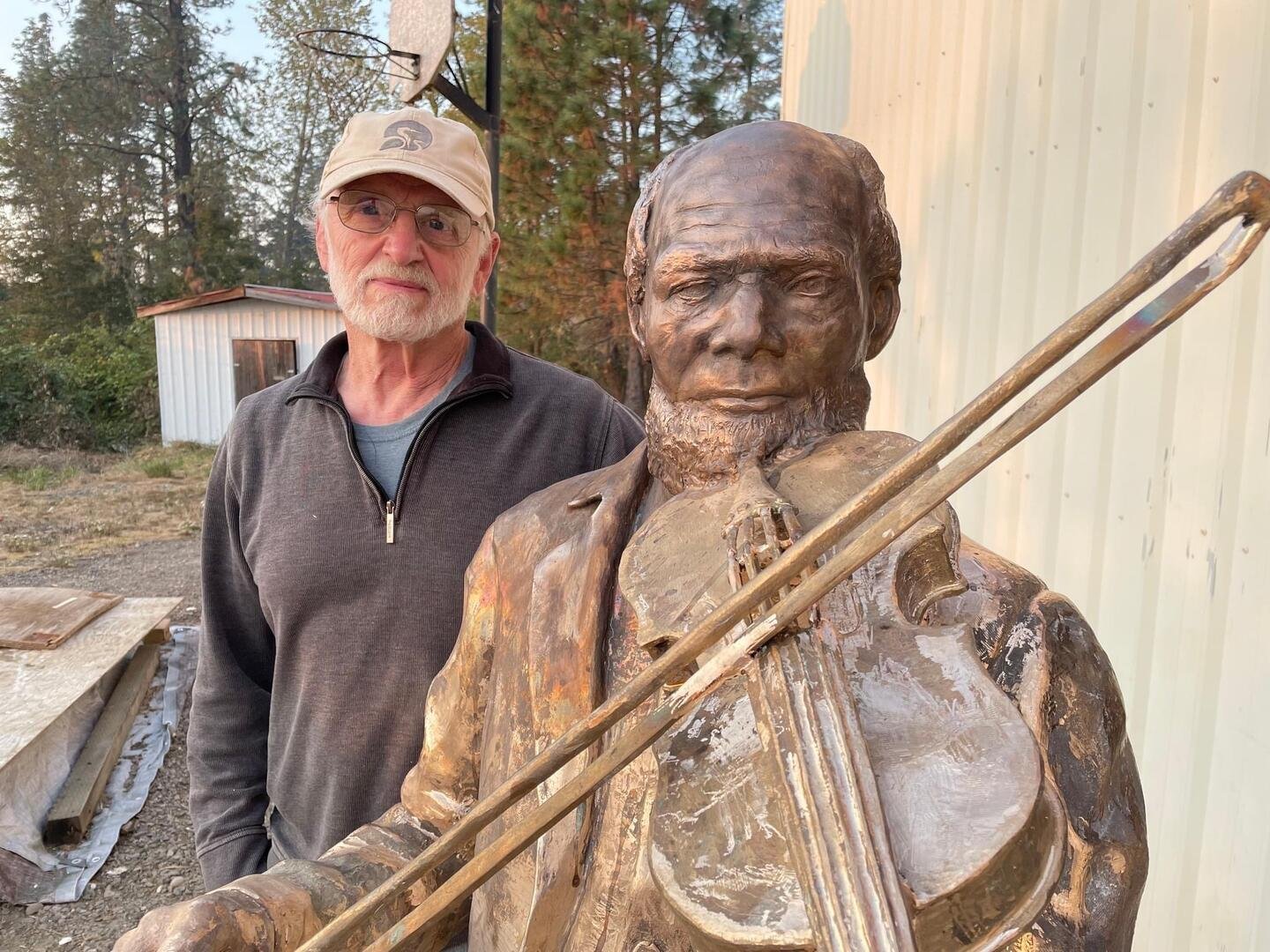A man of note
Waldport honors Black pioneer Louis Southworth with statue dedication
Sculptor Peter Helzer with the Southworth statue • Photo courtesy Jule Gilfillan/OPB
By Gretchen Ammerman
Oregon Coast TODAY
Waldport is soon to have a new park, named for an Oregon pioneer who helped to shape the area. Louis Southworth, who donated property for Waldport’s first schoolhouse, has now been immortalized by sculptor Peter Helzer.
The statue will be unveiled this Saturday, Nov. 19, at the Alsea Bay Bridge Visitor Center and Museum in a ceremony that will include food, beverages and live fiddle music. The sculpture will remain at the museum until it can be permanently located at the new Louis Southworth Park, planned to be open by the summer.
Louis was brought to Oregon enslaved.
Though slavery was not technically legal in the state, his “owner,” James Southworth, petitioned successfully to have Louis still be considered as his property. When James sent Louis to the gold fields in California and Nevada, Louis was able to keep some of the money he earned, but actually made more money entertaining people in the camps with his fiddle. At the age of 28, he bought his freedom for $1,000 and moved to Buena Vista, where he worked as a blacksmith, learned to read and write and married.
In 1879, Louis began homesteading about five miles east of Waldport with his wife and adopted son.
He ferried cargo and passengers and grew hay. On election day in 1880, when a fierce southwest storm raised whitecaps on the bay, Louis rigged two oil drums to his boat for buoyancy and rowed across to the polling place. He was the only man in Waldport to vote that day.
Serving for a time as chair of the school board, Louis donated land for a local schoolhouse. And he continued to entertain with his fiddle.
According to Zachary Stocks, executive director of Oregon Black Pioneers, Louis’ story was both typical and atypical of pioneers of African descent in Oregon.
“Like many enslaved people he didn’t have much freedom of movement,” Stocks said. “But he spent long portions of time away from the person that owned him. He owned a gun and was able to keep a portion of his earnings so, in that way, it was very different.”
The Oregon Black Exclusion law, first adopted in 1844 by the Provisional Government, mandated that Black people attempting to settle in Oregon would be publicly whipped with 39 lashes, repeated every six months until they left. There is no documented record of any official whippings but the message was clear. The Oregon Constitution, passed in 1859, contained an exclusion clause that made it illegal for African Americans to live in Oregon. That clause was not repealed until 1926.
“The exclusion laws were in place during the greatest expansion of population in the history of the state, so the black population wasn’t given the opportunity to grow at the same rate,” Stocks said. “That is why we have such a small proportion of people of African descent in the state to this day.”
Waldport native Jesse Dolin learned about Louis during a time when derogatory terms like “squaw,” were being removed from natural features and street names.
Darkey Creek and Darkey Creek Road in Waldport were named after Louis, based on, as history tells, his nickname. Changed in 1999, the creek is now Southworth Creek and the road, which went through Louis’ old homestead, is now Forest Road 3489.
“I grew up across the street from Darkey Creek Road and I always assumed it was in reference to the fact that salmon turn dark when they return from the ocean,” Dolin said. “When I heard about the name change and why it was happening, I grew interested in learning more about the story. After finding out how much he contributed to the area, I thought, ‘We need to honor this person.’”
The more he learned about Louis, the more impassioned Dolin became and he began the work that resulted in the new park and sculpture.
“It’s a story that deserves to be told,” he said. “There is such poetry about the fact that he donated land for the first schoolhouse in Waldport to have this memorial on the former school grounds.”
Peter Helzer, the sculptor tasked with immortalizing Louis in bronze, has sculptures all over the state including two in Eugene, “The Storyteller,” a memorial to Ken Kesey and the Rosa Parks sculpture in Rosa Parks Plaza.
“Memorials like these help to remind people that there is a history of black people living in Oregon, and it's an important statement about that community’s values,” Stocks said. “Having a monument to this very important Black person really helps send a message to people of African descent that they are welcome there.”
The Saturday, Nov. 19, unveiling ceremony begins at 1 pm at the Alsea Bay Bridge Visitor Center and Museum, located at 320 NW Hwy. 101 in Waldport.

